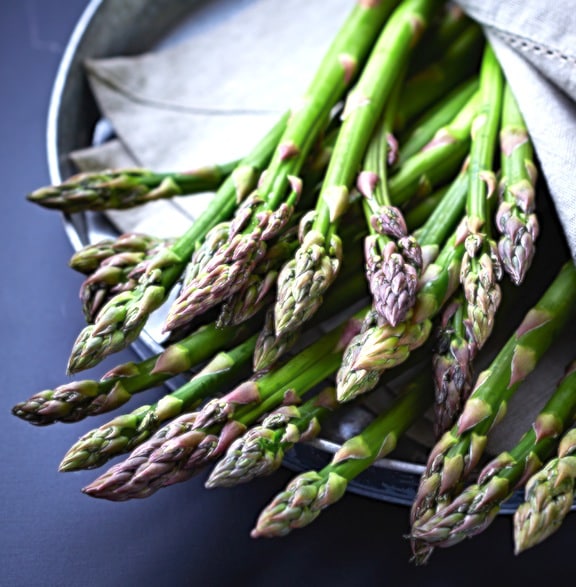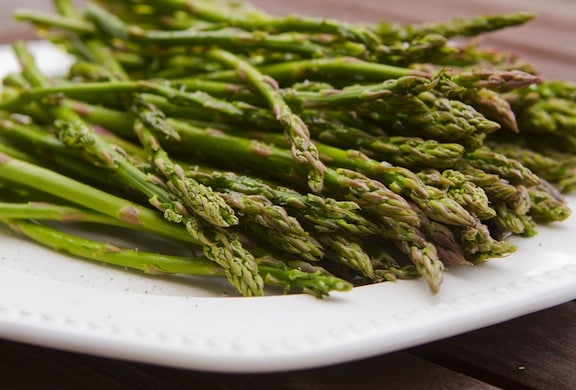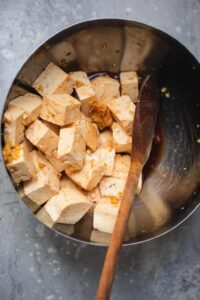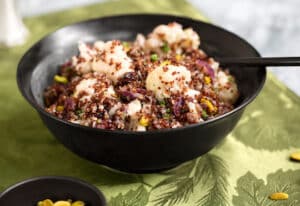It's only very recently that asparagus has become more of a year-round vegetable. Still, it's arguably one of the most associated with the arrival of spring. Asparagus lends itself to an assortment of fresh and delightful dishes as we'll see in this guide on how to use asparagus, with great tips on buying, cooking, freezing, and enjoying! Make sure to take a look at our listing of versatile and easy asparagus recipes.
In addition to being tasty and full of flavor, asparagus is an abundant source of a wide variety of nutrients, making it a ‘must' ingredient in every healthy and balanced diet. It is low in calories and sodium, and contains no fat. On the other hand, it supplies more folic acid than virtually any other vegetable and is an excellent source of potassium and vitamin B6.
Choosing the best asparagus
Whether choosing asparagus at the farmers market or at your local supermarket, look for bundles with firm spears whose tips are closed, plump and green, and avoid bundles that have even a hint of withered stalks. Slender asparagus is usually very nice, but too slender and you'll get mostly skin with little of the succulent stalks. Plump stalks aren't necessarily bad, but sometimes it's a sign of stringiness.
Like many things in life, going for the medium is usually a good bet.
Storing
Once you've made your pick, it's important to store your asparagus properly to keep it fresh and delicious, as it is a rather fragile vegetable. Wash it repeatedly in water until clean, pat it dry, and cut the harder stem ends – which are usually a lighter green – about an inch. Then, wrap a moist paper towel around the stems and place them in a plastic bag or container in the refrigerator. Or, even better, stand them upright in a couple of inches of cold water. If stored properly, they'll retain ultimate freshness for 2 or 3 days.
Freezing
Wash the asparagus thoroughly, trim the stems ends, and leave them whole or cut the spears as you wish. Blanch them (see below) in boiling water for 1 to 2 minutes only. Drain well and pack the asparagus in plastic freezer bags or containers, trying not to leave excess air space. Seal, label, and freeze at 0° F. You can use them for up to 8 months. Frozen asparagus doesn't need to be defrosted before cooking, and make sure you don't re-freeze previously frozen spears.
Cooking asparagus
Although it's perfectly safe to eat asparagus raw, it's usually better when lightly cooked. That's when its sweet, luscious flavor is released in all its intensity. Try warm steamed asparagus with a pinch of salt and a drizzle of olive oil and you'll be in heaven!
Blanching: To blanch asparagus, drop it whole, or already cut, into a large pot of simmering water and leave it for about 3-4 minutes. Then drain and shock by running it under cold water or putting it in an ice bath. When blanched, the texture of asparagus becomes a little softer, but still crisp, and the color brightens up.
Why do you blanch asparagus? Usually to soften the texture a bit before using other, faster cooking methods such as stir-frying and sautéing.
Steaming: Steaming is the perfect cooking method for a health-conscious diet because it utilizes very little or no fat. There is more than one technique for steaming asparagus, but the one that follows is tried and tested for guaranteed deliciousness.
In a large pot bring about 1 inch of water to a boil then reduce to a simmer. Fasten the asparagus stalks in a bundle with a string and place the bundle upright in the water. Cover and steam for 6 to 8 minutes or until tender. Alternatively, use a wide pan or Dutch oven and create a single layer of asparagus at the bottom (you may need to use less water). Cover and steam.
Stir-frying: Stir-frying is a very quick cooking technique that uses relatively low amounts of fat and very high heat. The secret is to keep the food in constant motion in a wok or sauté pan. Once you've cut the asparagus spears in the desired shape (cutting them on a slant is always nice for stir-fry dishes), blanch them, then heat a small amount of oil in the pan over high heat. Once the oil is hot enough, add the asparagus and stir constantly until tender but still crisp on the surface, about 3 to 5 minutes.
Sautéing: Sautéing asparagus is fairly similar to stir-frying. While stir-frying is more often used in the context of Asian-inspired recipes, sautéing is typical of Western cuisines. It's the cooking method most often used to prepare asparagus as side dishes to meat or fish entrees or in sauces for pasta. With sautéing as well as with stir-frying, it's preferable to use blanched asparagus for softer texture. In a skillet, heat up oil or butter, add the asparagus and cook, tossing every once in a while, until tender but still firm and crispy, about 3 to 5 minutes.
Roasting: Roasting brings out an amazing flavor in asparagus. Basically, you just need to roast whole stalks at 400º or 425º F for 10 to 15 minutes, depending on the thickness and how hot your oven runs. Since asparagus is so compact, you can even do a modest batch in a toaster oven. See Sesame-Roasted Asparagus for an easy recipe.
Contributed by Laura Giannatempo, reprinted from Sustainable Table/ GRACE Communications Foundation, by permission.
- Here's VegKitchen's entire listing of Asparagus Recipes.
- Get more by visiting VegKitchen’s Seasonal Produce Guides.








Barbara Pollak says
Ooh, I just bought 3 lbs asparagus this morning, and a friend I ran into (not over) said, "Buying produce for Passover already?" No, you dingbat, we still have to ear, and it's one of our favorite vegetables. Thanks for the suggestions for use! Last night was a black rice, baby spinach and cheddar pie. Like spanakopita only with rice instead of flaky pastry. Daia cheddar works nicely in this!
Janet Van Deren says
you forgot about grilling--my kids adore grilled asparagus (so do I 🙂 )
Caroline says
I roast it in the oven with a little garlic salt (no oil). The skinny ones take 7 minutes and the fat ones take 10 minutes at 450 degrees.
geni says
Who worries about how to store asparagus? I just bring it home and cook it and enjoy it the same day! Thanks for some new recipes for it though.